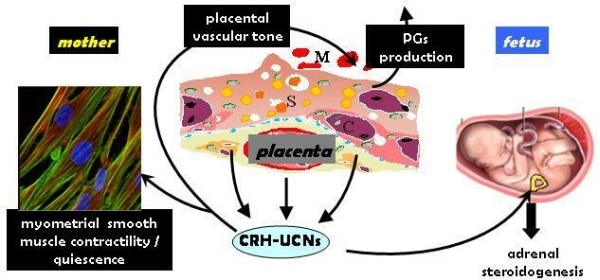CRH, the 41-aminoacid hypothalamic peptide, plays a fundamental role in mammalian survival and response to events that require “either a flight or fight” response. CRH’s role is to initiate and coordinate a series of adaptation mechanisms, involving activation of the HPA axis. It belongs to a family of mammalian peptides that includes the urocortins (UCNs-UCNI, UCNII and UCNIII. CRH expression was identified in human placenta, almost 20 years ago; however, its role during pregnancy and labour still remains a scientific enigma. Plasma levels of CRH might be an important predictor of the duration of human gestation. Furthermore, there are substantially increased concentrations of maternal circulating CRH in abnormal pregnancy states, for example in pre-eclampsia and intrauterine growth retardation. In some women with idiopathic preterm labour, concentrations of CRH increase up to 10 weeks before the development of any symptoms. During human pregnancy CRH appears to target multiple feto-maternal tissues, including the myometrium, placenta and fetal adrenals, implicating CRH in the mechanisms regulating uterine transition from relaxation to active contractions (1). In addition, CRH/urocortin, may generate prostaglandins from the fetal membranes and decidua, play a role in placental vasodilatation (2)and participate in fetal adrenal function and organ maturation. The actions of CRH are mediated via a wide network of specific G-protein coupled membrane-bound receptors (3). These receptors have various distinct and possibly opposing functional properties, depending on the receptor subtype, the ability of agonists to activate specific signalling cascades and the stage of pregnancy. In addition, their function is dependant upon other intracellular signals via communication between signalling cascades, suggesting potential multiple roles of CRH and other CRH-like peptides during pregnancy and labour. Established and emerging hypotheses about the role of CRH and CRH-R during pregnancy and labour will be discussed. Acknowledgements: This work was supported by the Wellcome Trust.Reference 1 : Grammatopoulos DK and Hillhouse EW (1999) Role of corticotropin-releasing hormone in onset of labour. Lancet. 354:1546-9Reference 2 : Vatish M, Randeva HS, Grammatopoulos DK (2006) Hormonal regulation of placental nitric oxide and pathogenesis of pre-eclampsia.Trends Mol Med. 12:223-33 Reference 3 : Hillhouse EW and Grammatopoulos DK (2006) The molecular mechanisms underlying the regulation of the biological activity of corticotropin-releasing hormone receptors: implications for physiology and pathophysiology. Endocr Rev. 27:260-86
University of Edinburgh (2007) Proc Physiol Soc 6, SA4
Research Symposium: Placental corticotropin-releasing hormone (CRH); role in human pregnancy and labour
D. Grammatopoulos1
1. Warwick Medical School, University of Warwick, Coventry, United Kingdom.
View other abstracts by:
Where applicable, experiments conform with Society ethical requirements.

